5 Easy Steps to Creating a Work-Life Balance: Harmonizing Personal and Professional Time in 2023
Table of Contents
There is no perfect work-life balance. However, achieving a work-life balance has become increasingly important for individuals seeking fulfillment and well-being in this demanding world.
Work-life balance can be defined as the state of equilibrium achieved when individuals effectively manage their personal and professional responsibilities, allowing them to allocate time and energy to both aspects of their lives.
It’s vital to assess your current situation honestly before beginning your journey towards work-life balance.
Achieving a work-life balance is a challenging task. Various challenges can hinder maintaining harmony between our personal and professional lives.
Maintaining work-life balance is not just about finding harmony between personal and professional life; it is a crucial driver of overall well-being and success.
I. Introduction
There is no perfect work-life balance. However, achieving a work-life balance has become increasingly important for individuals seeking fulfillment and well-being in this demanding world. The concept of work-life balance refers to the equilibrium between personal and professional commitments, allowing individuals to allocate time and energy to both aspects of their lives without sacrificing one. Are you seeking practical work-life balance tips to enhance your personal and professional well-being? In this instructional article, we will explore the importance of work-life balance and provide practical strategies to help you effectively manage your personal and professional time.
The pursuit of work-life balance has gained widespread recognition due to its numerous benefits. Discover the numerous work-life balance benefits that can positively impact your productivity, mental health, and overall satisfaction in both personal and professional realms. It enhances individual happiness and satisfaction and positively impacts productivity, mental health, and relationships. A healthy balance between work and personal life allows individuals to experience greater fulfillment, reduced stress levels, and improved overall well-being.
Are you seeking practical guidance on how to achieve work-life balance and strike a harmonious integration of your personal and professional life? The purpose of this article is to guide you through the process of creating a work-life balance that suits your unique circumstances and priorities. We will delve into various strategies and techniques that can help you assess your current situation, set priorities, manage time effectively, establish boundaries, prioritize self-care, foster communication, and collaboration, and navigate challenges that may arise along the way. Additionally, we will explore the concept of work-life balance within different professions and lifestyles and in the context of the digital age.
By implementing the strategies and techniques outlined in this article, you will have the tools for balancing personal and professional time, leading to a more fulfilling and balanced life. Let’s dive into the world of work-life balance and discover how you can achieve harmony between your personal and professional commitments.
II. Understanding Work-Life Balance
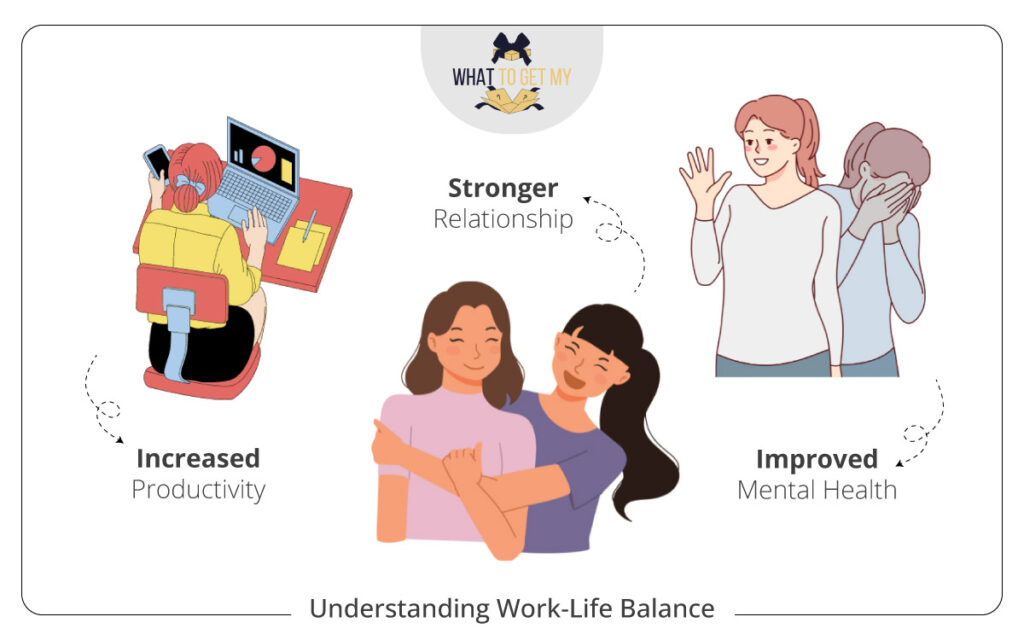
A. Definition and Significance
Work-life balance can be defined as the state of equilibrium achieved when individuals effectively manage their personal and professional responsibilities, allowing them to allocate time and energy to both aspects of their lives. It is about finding harmony and fulfillment by balancing work and personal commitments.
The significance of work-life balance cannot be overstated. In our modern society, where work demands are ever-increasing, it has become essential for maintaining overall well-being. When individuals prioritize and allocate time to their personal lives alongside their professional endeavors, they experience improved physical and mental health, enhanced relationships, and greater satisfaction.
Failure to achieve a work-life balance can have detrimental consequences. A lack of balance often leads to chronic stress, burnout, and decreased personal and professional performance. It can strain relationships, contribute to feelings of overwhelm and dissatisfaction, and negatively impact physical health. The consequences of an imbalance can manifest in various aspects of life, making it crucial to address and prioritize work-life balance.
B. Benefits of Work-Life Balance
1. Increased Productivity: Work-life balance has been found to enhance productivity. When individuals have time to recharge and engage in activities outside of work, they return to their professional roles with renewed focus, energy, and creativity. Taking breaks and investing in personal interests can boost productivity and efficiency in the long run.
2. Improved Mental Health: Maintaining a work-life balance improves mental health outcomes. By managing stress levels, individuals reduce the risk of experiencing burnout, anxiety, and depression. When prioritizing personal needs and well-being alongside work, it creates a healthier mental and emotional state, fostering overall happiness and life satisfaction.
3. Stronger Relationships: Work-life balance allows individuals to invest time and effort into nurturing personal relationships. Spending quality time with family and friends, engaging in hobbies, and participating in social activities strengthens connections and promotes a sense of belonging. Strong relationships serve as a support system, providing emotional stability during challenging times.
4. Enhanced Professional Success: A healthy work-life balance can contribute to long-term professional success. By managing personal commitments effectively, individuals can bring a sense of focus and dedication to their work. Additionally, a balanced approach promotes a positive work culture, teamwork, and a healthier work environment, ultimately leading to career growth and advancement opportunities.
Maintaining work-life balance is not just about finding harmony between personal and professional life; it is a crucial driver of overall well-being and success. Individuals can consciously achieve and maintain this balance by recognizing its significance and benefits. The following sections will explore practical strategies to help you create a work-life balance that suits your unique circumstances and goals.
III. Strategies for Achieving Work-Life Balance
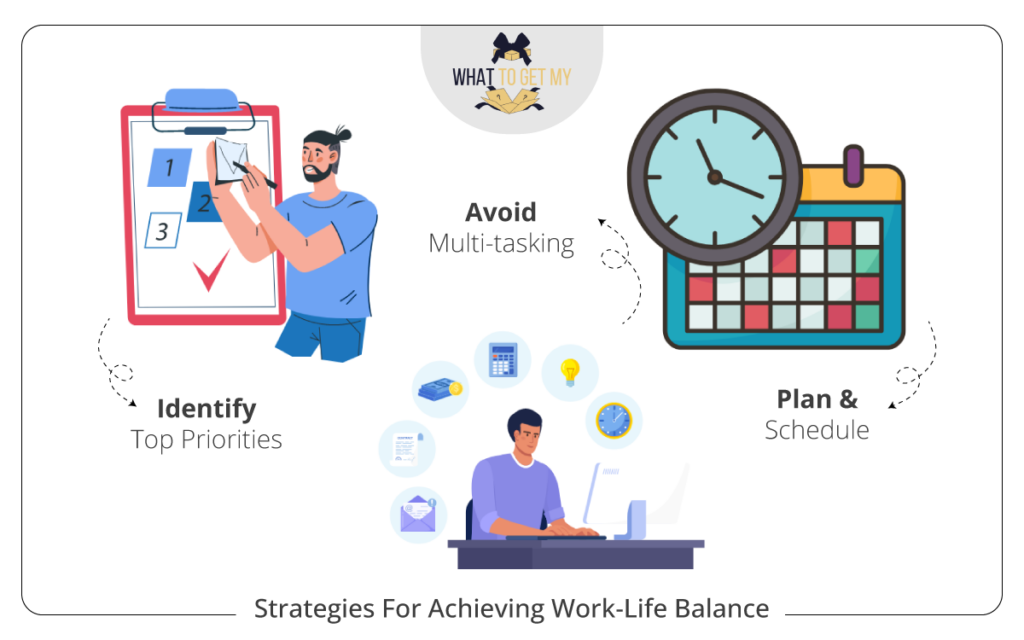
A. Assessing Your Current Situation
It’s vital to assess your current situation honestly before beginning your journey towards work-life balance. Take the time for self-reflection and evaluate how well you balance your personal and professional life. Consider the following questions:
1. How much time do you spend on work-related tasks and responsibilities compared to personal activities?
2. Do you often feel overwhelmed, stressed, or exhausted due to work demands?
3. Can you dedicate time to activities that bring you joy and fulfillment outside work?
4. How does your current work-life balance impact your relationships with family, friends, and yourself?
By honestly answering these questions, you can gain insights into areas that need improvement and identify specific aspects of your life that require more attention and balance.
B. Prioritization and Time Management
Setting priorities and managing time effectively is essential for achieving work-life balance. Consider the following strategies:
1. Identify your top priorities: Determine the most critical areas of your life, such as family, health, career, hobbies, and personal growth. This will help you allocate time and energy accordingly.
2. Plan and schedule: Use tools like calendars or planners to schedule work and personal activities. Create a realistic timetable that allows for dedicated time for each priority.
3. Delegate and outsource: Delegate tasks at work and home to lighten your workload. Consider outsourcing specific responsibilities to professionals or seeking help from family members or friends.
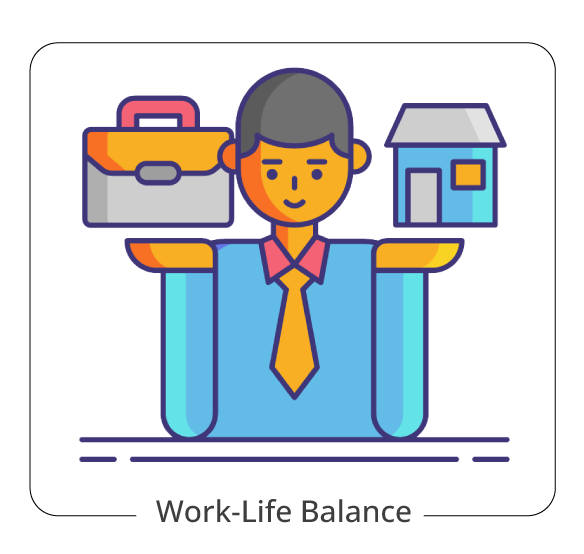
4. Avoid multitasking: Focus on one task at a time to enhance productivity and reduce stress. You can complete tasks more efficiently and enjoy more significant accomplishments by giving your full attention to each activity.
C. Setting Boundaries
Establishing clear boundaries between work and personal life is crucial for maintaining a work-life balance. Consider these strategies:
1. Define your work hours: Set specific start and end times for your workday. Stick to these hours and avoid unnecessary work-related activities outside those designated times.
2. Create a dedicated workspace: Designate a specific area for work-related tasks. This helps create a physical boundary and signals to others that you are in work mode.
3. Limit digital distractions: Set boundaries with technology by turning off notifications or establishing specific times for checking emails and messages. This allows you to be fully present during personal activities.
4. Communicate your boundaries: Communicate your boundaries to colleagues, supervisors, and family members. Let them know your availability and when you should not be disturbed unless it is an emergency.
D. Self-Care and Well-being
Prioritizing self-care is vital for maintaining a work-life balance. Consider the following practices:
1. Make time for relaxation and hobbies: Engage in activities that bring you joy and relaxation, such as exercise, reading, painting, or spending time in nature. Schedule regular breaks and dedicate time to these activities.
2. Take care of your physical health: Maintain a balanced diet, get enough sleep, and exercise regularly. Prioritizing your physical well-being enhances your energy levels and overall resilience.
3. Practice mindfulness and stress management: Incorporate mindfulness techniques, such as meditation or deep breathing exercises, into your daily routine. These practices help reduce stress and promote mental clarity.
4. Disconnect and recharge: Take regular breaks from technology and work-related responsibilities. Unplug during weekends or vacations to recharge and rejuvenate.
E. Communication and Collaboration
Effective communication and collaboration play a significant role in achieving work-life balance. Consider the following strategies:
1. Open and honest communication: Communicate your needs, limitations, and expectations with colleagues, supervisors, and family members. Discuss potential conflicts and find mutually beneficial solutions.
2. Seek support when needed: Don’t hesitate to ask for help or delegate tasks when overwhelmed. Collaborate with colleagues or seek assistance from family members to lighten your load.
3. Foster teamwork and collaboration: Encourage a supportive and collaborative work environment. By working together and helping one another, you can create a culture that promotes work-life balance for everyone.
F. Flexibility and Adaptability
Flexibility and adaptability are essential for managing personal and professional commitments. Consider the following strategies:
1. Embrace a flexible work arrangement: Explore flexible working hours, remote work, or compressed work weeks. These arrangements can provide more control over your schedule and improve your work-life balance.
2. Embrace change and unexpected situations: Life is unpredictable, and unforeseen circumstances may arise. Develop resilience and adaptability to navigate these situations while maintaining your work-life balance.
3. Continuously reassess and adjust: Regularly evaluate your work-life balance and adjust as needed. Priorities and circumstances may change, so be open to reevaluating and fine-tuning your approach.
These strategies will set you on your way to creating a healthy work-life balance that aligns with your values, priorities, and personal circumstances. Remember, achieving and maintaining work-life balance is a continuous journey that requires conscious effort, self-awareness, and regular evaluation.
IV. Overcoming Work-Life Balance Challenges
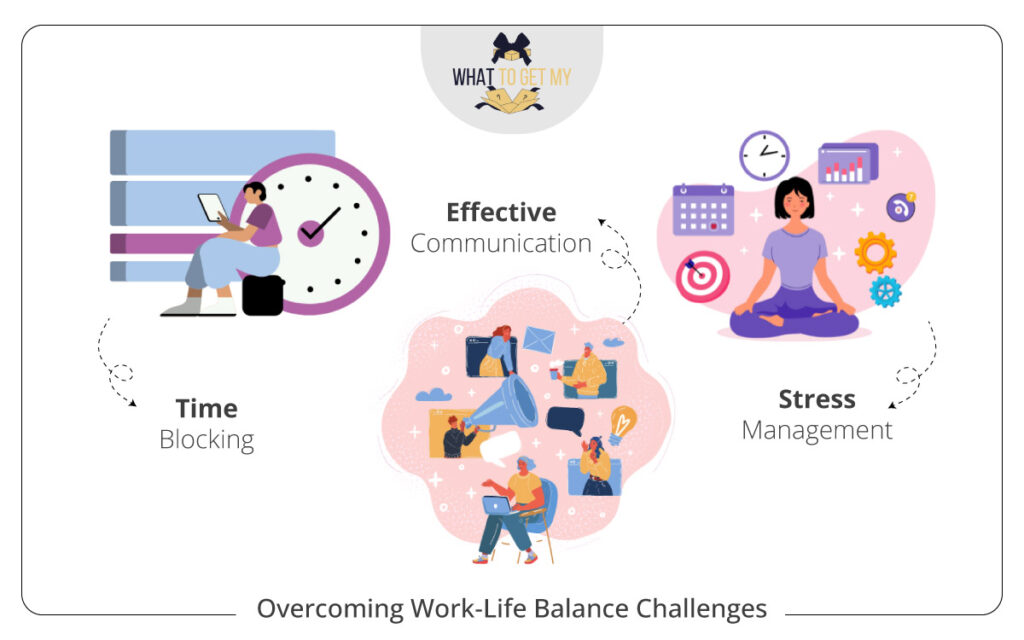
A. Common Challenges
Achieving a work-life balance is a challenging task. Various challenges can hinder maintaining harmony between our personal and professional lives. By understanding these challenges and their underlying causes, we can proactively address them. Here are some common obstacles to achieving work-life balance and potential solutions:
1. High Workload and Time Demands: Heavy workloads, long hours, and demanding deadlines can leave little time for personal pursuits and relaxation. This imbalance can lead to increased stress levels and diminished well-being.
Solution: Prioritize and delegate tasks, when possible, to lighten your workload. Improve time management skills by identifying and focusing on high-priority tasks. Learn to say no to nonessential commitments and set realistic expectations with supervisors and colleagues.
2. Lack of Boundaries: Blurring the boundaries between work and personal life can make disconnecting and engaging in non-work activities difficult. Constant accessibility and the expectation of immediate responses can infringe on personal time and disrupt the work-life balance.
Solution: Establish clear boundaries by setting designated work hours and non-work hours. Communicate your boundaries to colleagues, supervisors, and family members. Utilize technology tools, such as email filters or do-not-disturb settings, to minimize interruptions during personal time.
3. Inadequate Support Systems: Limited support from colleagues, supervisors, or family members can make juggling personal and professional responsibilities challenging. Lack of understanding or flexibility from others can create additional stress and strain.
Solution: Foster open communication and seek support when needed. Advocate for your needs and communicate the importance of work-life balance to your support network. Collaborate with colleagues and supervisors to find mutually beneficial solutions. Consider joining support groups or seeking mentorship to gain additional guidance.
4. Perfectionism and Overcommitment: Striving for perfection and taking on too many commitments can lead to an imbalance in work and personal life. The pursuit of excellence in all areas can result in constant pressure and feelings of being overwhelmed.
Solution: Practice self-awareness and set realistic expectations. Prioritize tasks and focus on what matters. Learn to delegate and let go of the need for perfection. Embrace a mindset of self-compassion and recognize that it’s okay to prioritize self-care and well-being.
B. Work-Life Harmony Techniques
Specific techniques that overcome these common challenges can enhance work-life balance. Consider implementing the following practical approaches:
1. Time Blocking: Allocate specific time blocks for work, personal activities, and self-care. Plan your schedule, giving equal importance to personal commitments alongside work-related tasks.
2. Mindfulness and Stress Management: Incorporate mindfulness techniques, such as meditation, deep breathing exercises, or mindfulness breaks, to reduce stress and promote a sense of calm. Engage in activities that help you relax and recharge, such as yoga or walking in nature.
3. Flexible Work Arrangements: Explore flexible work options, such as remote work or flexible hours, to accommodate personal needs and responsibilities. Discuss these possibilities with your employer or supervisor, highlighting the potential benefits for productivity and work-life balance.
4. Effective Communication: Communicate your availability, boundaries, and priorities to colleagues, supervisors, and family members. Use assertive communication techniques to express your needs and concerns, fostering understanding and support.
5. Practice Self-Care: Prioritize self-care activities that nurture your physical, mental, and emotional well-being. This can include exercise, hobbies, quality time with loved ones, or engaging in activities that bring you joy and relaxation.
6. Regular Evaluation and Adjustments: Continuously reassess your work-life balance and make necessary adjustments. As circumstances change, your priorities may shift, requiring modifications to your approach. Regularly evaluate what is working well and what needs improvement.
By implementing these techniques and approaches, you can overcome common work-life balance challenges and create a healthier and more fulfilling integration of personal and professional life. Remember that work-life balance is a continuous process, and finding the right balance requires ongoing self-reflection, adjustment, and self-care.
Recent findings from the Organisation for Economic Co-operation and Development (OECD) reveal that Italy ranks highest in work-life balance, according to Statista, highlighting the significance of work hours, leisure time, and the prevalence of long working hours. Unsurprisingly, maintaining a healthy work-life balance depends on how much time individuals dedicate to work, avoiding excessive working hours, and the availability of leisure time. The authors of the Better Life Index further emphasize that prolonged work hours may harm personal health, compromise safety, and contribute to elevated stress levels.
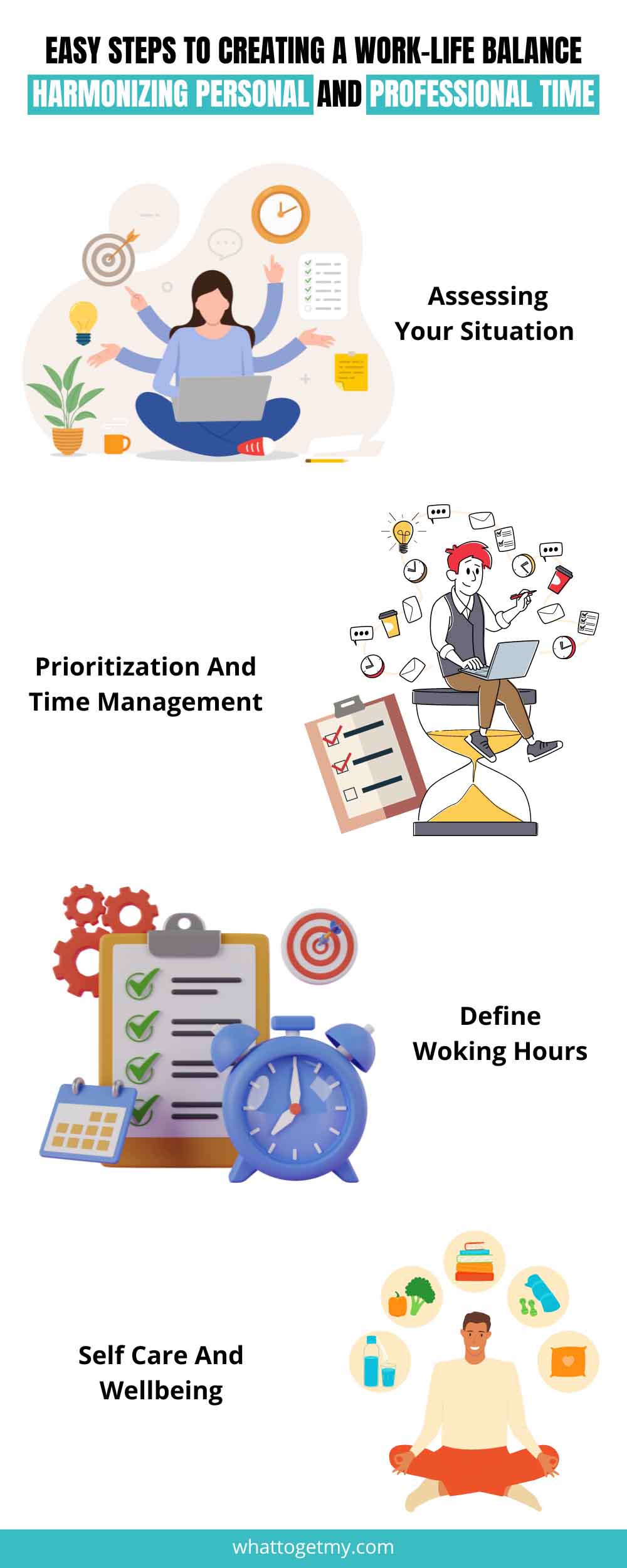
V. Work-Life Balance in Different Professions and Lifestyles
Achieving a work-life balance can vary depending on the nature of one’s profession and lifestyle. Work-life balance for busy professionals is a challenge, but finding ways to make time for both work and personal life is essential. Different industries and personal circumstances present unique challenges and opportunities for balancing work and personal life. Understanding these considerations and tailoring strategies can significantly contribute to finding harmony. Let’s explore work-life balance considerations for various professions and lifestyles and provide tailored tips and advice:
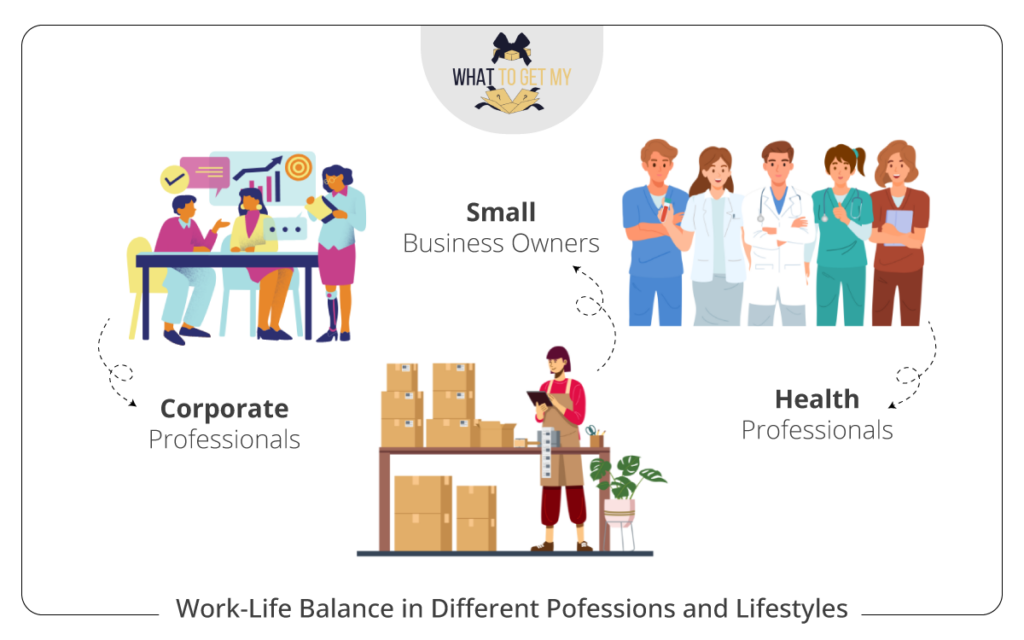
A. Corporate Professionals:
– Prioritize task delegation and effective time management to handle demanding workloads.
– Set boundaries and learn to disconnect from work during non-work hours.
– Explore flexible work arrangements, such as telecommuting or flexible schedules.
– Practice stress-management techniques and engage in regular self-care activities.
B. Entrepreneurs and Small Business Owners:
– Create a support network of professionals, mentors, or business partners who can share the workload and offer guidance.
– Delegate tasks that can be outsourced or handled by employees.
– Implement efficient systems and processes to streamline operations and reduce time constraints.
– Set realistic expectations and avoid over-committing by prioritizing essential tasks.
C. Healthcare Professionals:
– Utilize shift scheduling options to create time for personal commitments.
– Seek support from colleagues and supervisors to manage workload and avoid burnout.
– Take advantage of self-care resources within the healthcare field, such as counseling or wellness programs.
– Practice boundary-setting to ensure personal time is protected.
D. Creative Professionals (Artists, Writers, Designers):
– Create structured routines to balance creative work and personal life.
– Embrace flexible work hours that align with your creative flow and inspiration.
– Set realistic goals and manage deadlines effectively to avoid last-minute pressure.
– Establish boundaries to protect uninterrupted creative time and minimize distractions.
E. Remote Workers:
– Designate a dedicated workspace to separate work from personal life.
– Establish a consistent daily routine to maintain structure and boundaries.
– Communicate expectations with family members or housemates to minimize interruptions during working hours.
– Prioritize self-discipline and time management to avoid excessive or insufficient work hours.
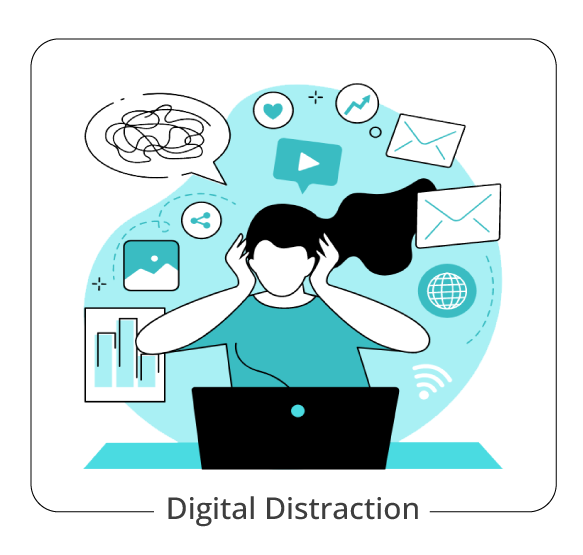
F. Parents:
– Leverage parental leave options and flexible work arrangements to accommodate childcare responsibilities.
– Communicate openly with employers about family obligations and explore flexible scheduling options.
– Delegate tasks and seek support from partners, family members, or trusted caregivers.
– Practice self-compassion and accept that achieving perfect balance may not always be feasible.
G. Students:
– Create a study schedule that includes dedicated breaks for personal activities.
– Develop practical time management skills to balance academic commitments with leisure time.
– Seek support from classmates, professors, or academic resources when overwhelmed.
– Prioritize self-care and maintain a healthy balance between study and relaxation.
Remember that work-life balance is unique to each individual, and it’s crucial to adapt strategies to suit your specific circumstances. Regularly reassess and adjust your approach to accommodate your profession or lifestyle changes. With conscious effort and a focus on personal well-being, you can find harmony between your professional and personal life, regardless of your industry or lifestyle.
VI. Work-Life Balance in the Digital Age
The rapid advancement of technology has transformed how we work and live, presenting opportunities and challenges when it comes to achieving work-life balance. The constant connectivity and digital distractions can blur the boundaries between work and personal life, making it more challenging to find harmony. In this section, we will discuss the impact of technology on work-life balance and provide strategies for managing digital distractions and establishing healthy boundaries:
A. Impact of Technology on Work-Life Balance:
1. Increased Connectivity: Technology has made us constantly accessible, blurring the line between work and personal life. Emails, instant messaging, and remote work capabilities can lead to an “always-on” mentality, making it difficult to disconnect and recharge.
2. Digital Distractions: Social media, notifications, and entertainment platforms can easily consume our time and attention, diverting us from important personal and professional activities. This can lead to decreased productivity and a sense of imbalance.
3. Blurred Work-Life Boundaries: With remote work and flexible schedules becoming more prevalent, it can be challenging to separate work and personal life physically and mentally. This can result in overworking, neglecting personal time, and causing stress and burnout.
B. Strategies for Managing Digital Distractions and Establishing Healthy Boundaries
1. Set Boundaries: Establish clear guidelines for technology use. Define specific times and spaces where technology is off-limits, such as during meals or before bedtime. Communicate these boundaries to colleagues, family, and friends.
2. Practice Digital Detox: Regularly disconnect from technology for designated periods. Schedule breaks from email, social media, and work-related tasks. Use this time for personal activities, relaxation, and connecting with loved ones.
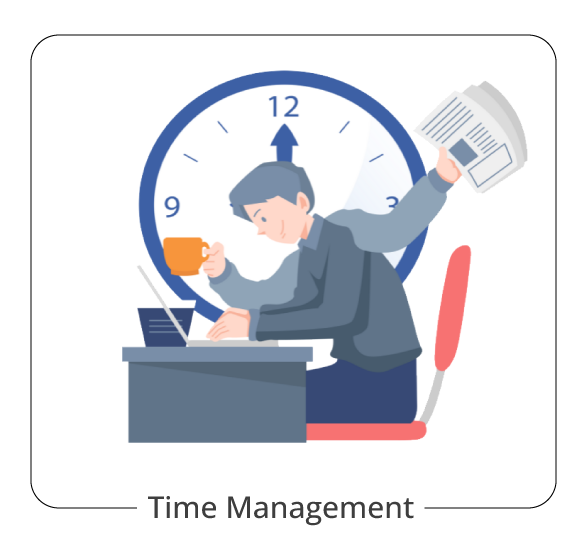
3. Utilize Productivity Tools: Explore apps and tools designed to enhance productivity and manage distractions. Use timers or productivity trackers to focus on tasks, block distracting websites, or enable “Do Not Disturb” device features.
4. Optimize Notifications: Review and customize notification settings to minimize interruptions. Disable non-essential notifications and prioritize important ones. Consider setting specific times to check emails and messages rather than being constantly reactive.
5. Designate Tech-Free Zones: Create spaces in your home or areas during personal activities where technology is not allowed. This can include bedrooms, dining areas, or designated relaxation areas.
6. Practice Mindfulness: Develop mindfulness techniques to manage digital distractions and increase present-moment awareness. Engage in meditation, deep breathing exercises, or mindfulness breaks to refocus and reduce stress.
7. Establish “Work” and “Non-Work” Rituals: Create rituals or routines that signify the start and end of work or personal time. This can include specific activities like changing clothes, walking, or listening to music. These rituals can help transition between different aspects of life.
8. Prioritize Self-Care: Allocate dedicated time for self-care activities that promote relaxation and well-being. Enjoy physical exercise, hobbies, or spend quality time with loved ones. By prioritizing self-care, you enhance overall well-being and reduce the impact of technology-induced stress.
Remember, finding a healthy work-life balance in the digital age requires conscious effort and ongoing evaluation. Regularly assess your technology habits, adjust boundaries as needed, and prioritize activities that bring fulfillment and rejuvenation. By managing digital distractions and establishing healthy boundaries, you can regain control over your time, enhance productivity, and foster a better work-life balance in the digital era.
Frequently Asked Questions
Q1: How can I assess my current work-life balance?
A1: Assessing your current work-life balance involves self-reflection and evaluation. Start by examining how much time and energy you allocate to work versus your personal life. Consider factors such as the number of hours you work, the level of stress you experience, and the quality of your relationships. Ask yourself if you feel fulfilled and your current balance aligns with your priorities and values. Being honest with yourself will help identify areas that need improvement.
Q2: Is it possible to achieve work-life balance in a demanding profession?
A2: Yes, it is possible to achieve work-life balance even in demanding professions. While it may require more effort and strategic planning, setting boundaries, prioritizing tasks, and practicing effective time management are crucial. Delegate tasks when possible, leverage technology and tools to streamline work processes and communicate your needs with colleagues and supervisors. Remember that achieving work-life balance is about finding harmony, and with the right strategies and mindset, it can be attained in any profession.
Q3: How can I manage digital distractions and establish healthy boundaries in the digital age?
A3: Managing digital distractions and establishing healthy boundaries in the digital age is essential for work-life balance. Here are a few strategies:
– Set specific times to check emails and messages rather than constantly being reactive.
– Customize notification settings to minimize interruptions and prioritize important notifications.
– Designate tech-free zones or times where you disconnect from technology.
– Practice digital detox by taking regular breaks from social media and other digital platforms.
– Utilize productivity tools and apps to manage distractions and enhance focus.
– Establish rituals or routines that signify the start and end of work or personal time.
– Prioritize self-care and engage in activities that promote relaxation and well-being away from screens.
By implementing these strategies, you can regain control over your digital habits, reduce distractions, and establish boundaries that support a healthier work-life balance.
VII. Conclusion
In this article, we have explored the concept of work-life balance and provided valuable insights and strategies to help you harmonize your personal and professional time. Let’s recap the key points discussed:
1. Understanding Work-Life Balance: We defined work-life balance and highlighted its significance for overall well-being. We discussed the potential consequences of an imbalance and explored the benefits of achieving work-life balance, including increased productivity, improved mental health, and stronger relationships.
2. Strategies for Achieving Work-Life Balance: We provided a range of strategies to help you achieve work-life balance. These included assessing your current situation, prioritization and time management, setting boundaries, practicing self-care and well-being, effective communication and collaboration, and embracing flexibility and adaptability.
3. Overcoming Work-Life Balance Challenges: We identified common challenges to work-life balance and offered insights into their causes and potential solutions. We also introduced techniques to overcome these challenges, such as time blocking, mindfulness and stress management, and effective communication.
4. Work-Life Balance in Different Professions and Lifestyles: We acknowledged that work-life balance considerations could vary across different professions and lifestyles. We provided tailored tips and advice for individuals in corporate professions, entrepreneurship, healthcare, creative fields, remote work, parenting, and student life.
5. Work-Life Balance in the Digital Age: We discussed the impact of technology on work-life balance and offered strategies for managing digital distractions and establishing healthy boundaries. These included setting boundaries, practicing digital detox, utilizing productivity tools, optimizing notifications, and prioritizing self-care.
It is essential to recognize that work-life balance is not a one-size-fits-all concept. It is a personal journey that requires self-reflection, continuous evaluation, and adaptation. By implementing the strategies and techniques outlined in this article, you can create a work-life balance that aligns with your values, priorities, and personal circumstances.
Remember, achieving work-life balance is crucial not only for your well-being but also for your personal and professional success. It allows you to thrive in both areas and experience greater life satisfaction. Take proactive steps to implement the strategies discussed and make work-life balance a priority in your life.
As you embark on this journey, be patient and kind to yourself. It may take time to find the right balance, but with determination and perseverance, you can achieve it. Prioritize your well-being, set boundaries, and nurture your personal and professional lives. Embrace the power of work-life balance and reap the rewards it brings to your happiness and fulfillment.
02 HOURS 47 MINUTES
ESTIMATED TIME DESIGNING AND UPLOADING THIS ARTICLE
08 HOURS 29 MINUTES
ESTIMATED TIME RESEARCHING AND WRITING THIS ARTICLE
LOOKING FOR MORE GIFTS?
Try our AMAZING GIFT FINDER TOOL! Find GIFTS with 1 CLICK!
LOOKING FOR MORE GIFTS?
Try our AMAZING GIFT FINDER TOOL! Find GIFTS with 1 CLICK!
LOOKING FOR MORE GIFTS?
Try our AMAZING GIFT FINDER TOOL! Find GIFTS with 1 CLICK!
You Might Also Like

What To Get My Techie Husband For Christmas
Looking for gift ideas for someone precious like your husband can be difficult, especially if he is a techie person, and you’re not. You might be left wondering and asking yourself, “what to get my techie husband for Christmas?” What makes it hard is the

How to Deal with a Difficult Friend
7 Simple Dos and Don’ts on How to Deal with a Difficult Friend Effortlessly (2023) Friendships are essential to our lives, but occasionally we encounter challenging dynamics that require careful navigation. By taking the time to understand your difficult friend’s perspective, you can approach the

What Foods Should We Eat to Maintain a Healthy Lifestyle?
What Foods Should We Eat to Maintain a Healthy Lifestyle? WhatToGetMy Instructional Article If you’re wondering what foods should we eat to maintain a healthy lifestyle, just keep scrolling. We discussed diet and its relation to an active lifestyle. A healthy diet is about finding

How to Decorate a Bridal Shower Chair – 15 Ideas to Jazz Up Your Bridal Shower Chair
How to Decorate a Bridal Shower Chair – 15 Ideas to Jazz Up Your Bridal Shower Chair WhatToGetMy Instructional Article Someone special in your life is a bride-to-be, and you are planning a bridal shower to send them off properly. Hosting any event can be

WHAT DO YOU GET A BOY FOR HIS BAPTISM
What do you get a boy for his baptism WhatToGetMy Instructional Article You have been invited to a baptism for a boy which will be one of the most special days for both the parents as well as the little boy to have in their

How to Surprise your Boyfriend for No Reason
Guide On How to Surprise your Boyfriend for No Reason WhatToGetMy Instructional Article Ask every girl out there what she wants, and 90% of the time, she’ll say “ways of how to surprise your boyfriend for no reason.” Women are forever combing through magazines, asking

11 Cute Things to Send to Your Boyfriend in the Mail
You may decide to send someone a gift through the mail as a sentimental gesture or because you are in a long distance relationship and the easiest way to get items to them is through the mail. There are several items that are allowed to

9 Things to Do When Your Boyfriend is Sick
9 Things to Do When Your Boyfriend is Sick WhatToGetMy Instructional Article It hurts to see any of our loved ones in pain, especially if we know we cannot be of much help. A sickness, of course, varies in severity from person to person. We

What to Buy a Tween for Her Birthday?
You’re probably sitting at your desk scrolling through endless pages of gift recommendations that don’t help you decide what to buy a tween for her birthday. This is not one of those articles. We’ll give you a list of cool tween gifts but we’ll keep

What Is the Purpose of Valentine’s Day
What Is the Purpose of Valentine’s Day WhatToGetMy Instructional Article With Valentine’s Day approaching, you must have noticed the increased number of flowers, heart-shaped chocolates, and all kinds of red items in the stores. At some point, you pause in the middle of whatever you’re



